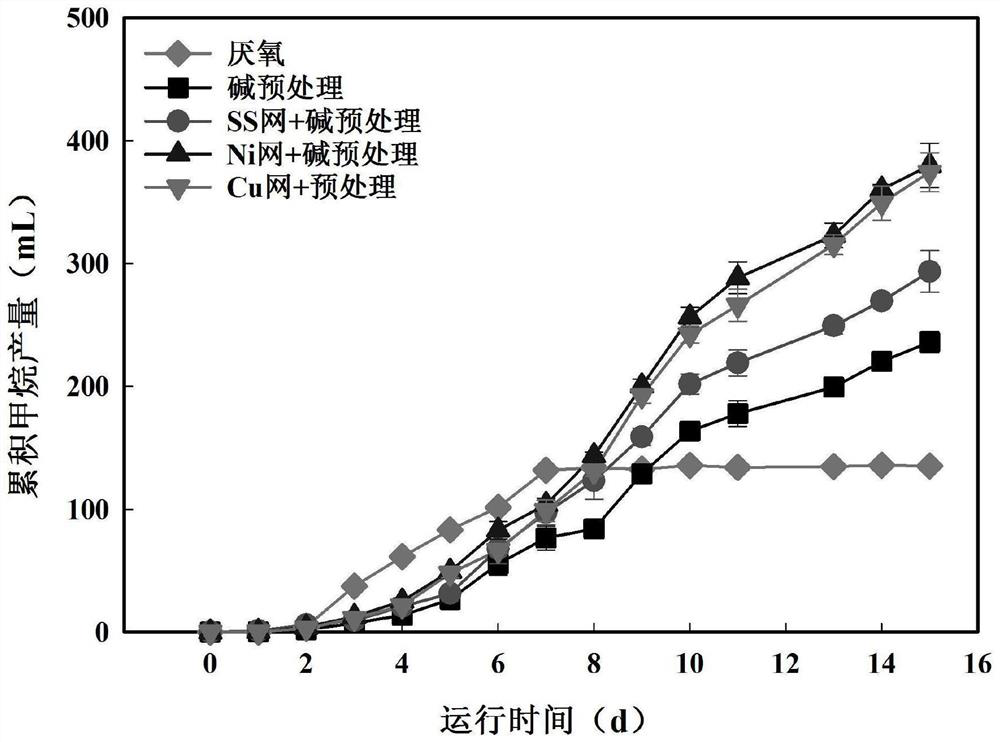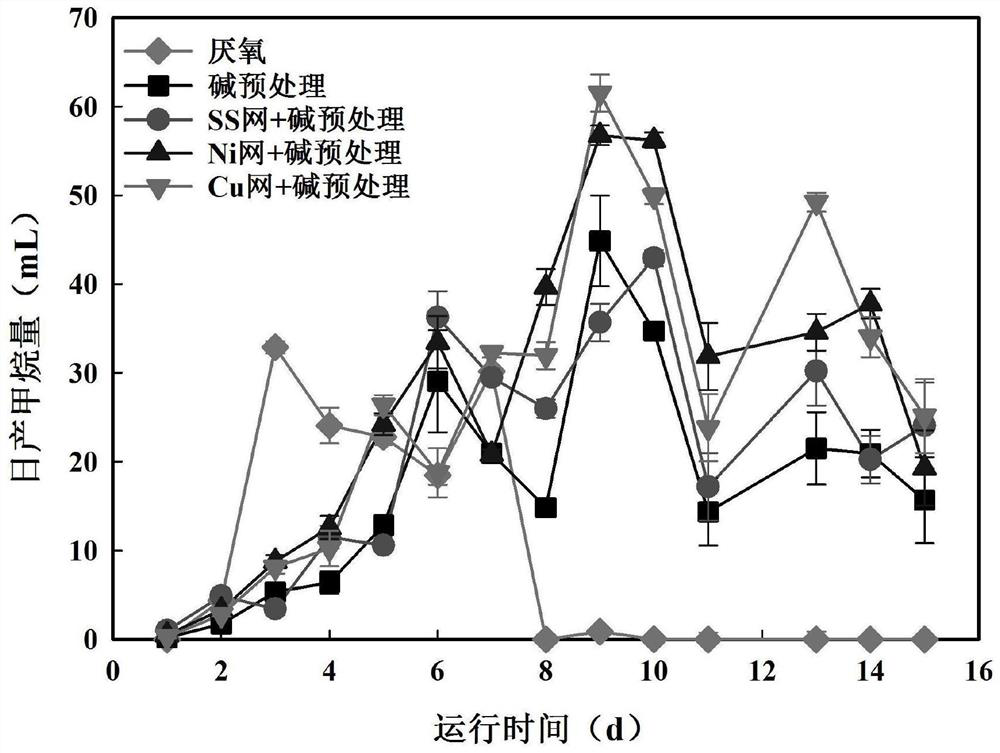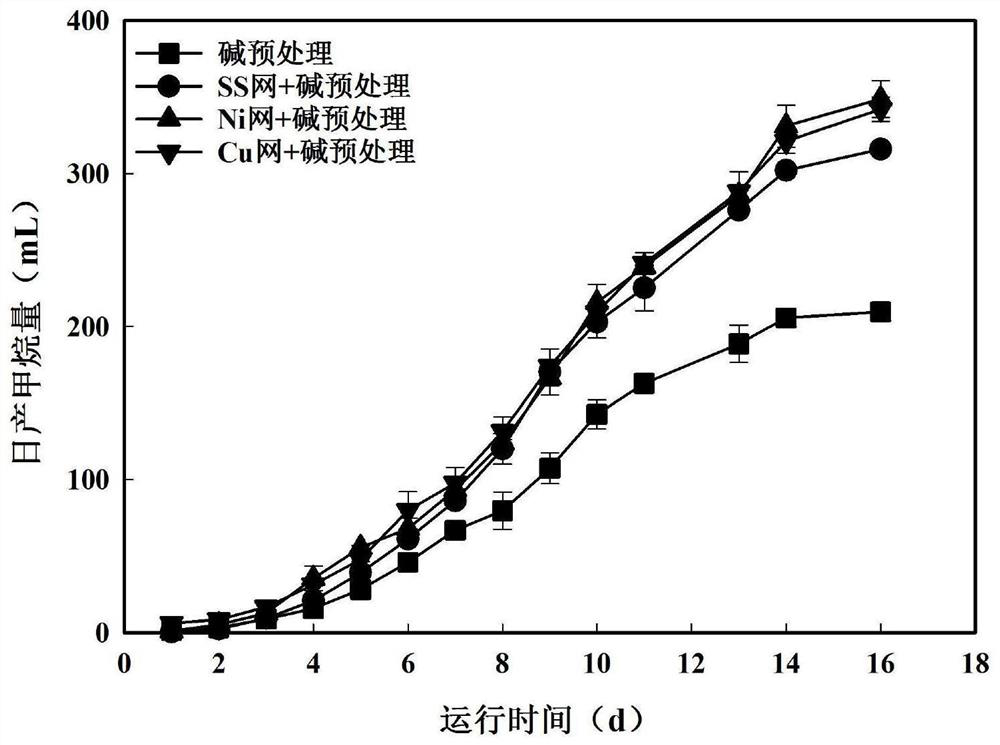Method for promoting anaerobic digestion of excess sludge to produce methane by combining metal conductive material with sludge pretreatment
A technology for excess sludge and metal conduction, applied in biological sludge treatment, waste fuel, etc., can solve the problems of low methane production rate and low hydrolysis rate, and achieve high unit methane production rate, strong mechanical strength, and convenient recycling Effect
- Summary
- Abstract
- Description
- Claims
- Application Information
AI Technical Summary
Problems solved by technology
Method used
Image
Examples
Embodiment 1
[0027] Embodiment 1: In this embodiment, the method of metal conductive material combined with sludge pretreatment to promote anaerobic digestion of excess sludge to produce methane is carried out according to the following steps:
[0028] Step 1. Pretreatment of metal mesh: Take 200 mesh stainless steel mesh (SS-M), cut SS-M into 6.25mm×6.25mm pieces, and take the total area as 200cm 2 The SS-M fragments were soaked in HCl solution with a concentration of 5mol / L for 24 hours to remove the surface oxide film, washed with distilled water until neutral, and dried in a vacuum oven at 40°C for later use.
[0029] Step 2. Pretreatment of excess sludge: The excess sludge in the secondary settling tank is naturally settled for 12 hours. After removing the supernatant, adjust the sludge concentration to 12g / L for later use, and then adjust the pH value to 10-11 with 4mol / L NaOH solution. Adjust once every 10 minutes, adjust 3 times in total, and refrigerate at 4°C for later use;
[0...
Embodiment 2
[0034] Embodiment 2: In this embodiment, the metal conductive material combined with sludge pretreatment method to promote the anaerobic digestion of excess sludge to produce methane is carried out according to the following steps:
[0035] Step 1. Pretreatment of metal mesh: take 200 mesh nickel mesh (Ni-M), cut Ni-M into 6.25×6.25mm pieces, and take the total area as 200cm 2 The nickel mesh fragments were soaked in HCl solution with a concentration of 6mol / L for 24 hours to remove the surface oxide film, washed with distilled water until neutral, and dried in a vacuum oven at 40°C for later use.
[0036] Step 2. Pretreatment of excess sludge: The excess sludge in the secondary settling tank is naturally settled for 24 hours. After removing the supernatant, adjust the sludge concentration to 14g / L for later use, and then adjust the pH value to 10 with 6mol / L NaOH solution, every 10min Adjust once for a total of 3 times, and refrigerate at 4°C for later use;
[0037] Step 3. ...
Embodiment 3
[0039] Embodiment 3: In this embodiment, the metal conductive material combined with sludge pretreatment method to promote the anaerobic digestion of excess sludge to produce methane is carried out according to the following steps:
[0040] Step 1. Pretreatment of metal mesh: take 200-mesh copper mesh (Cu-M), cut Cu-M into 6.25mm×6.25mm pieces, and take the total area as 200cm 2The nickel mesh fragments were soaked in HCl solution with a concentration of 6mol / L for 24 hours to remove the surface oxide film, washed with distilled water until neutral, and dried in a vacuum oven at 40°C for later use.
[0041] Step 2. Pretreatment of excess sludge: The excess sludge in the secondary settling tank is naturally settled for 24 hours. After removing the supernatant, adjust the sludge concentration to 14g / L for later use, and then adjust the pH value to 10 with 6mol / L NaOH solution, every 10min Adjust once for a total of 3 times, and refrigerate at 4°C for later use;
[0042] Step 3....
PUM
 Login to View More
Login to View More Abstract
Description
Claims
Application Information
 Login to View More
Login to View More - R&D
- Intellectual Property
- Life Sciences
- Materials
- Tech Scout
- Unparalleled Data Quality
- Higher Quality Content
- 60% Fewer Hallucinations
Browse by: Latest US Patents, China's latest patents, Technical Efficacy Thesaurus, Application Domain, Technology Topic, Popular Technical Reports.
© 2025 PatSnap. All rights reserved.Legal|Privacy policy|Modern Slavery Act Transparency Statement|Sitemap|About US| Contact US: help@patsnap.com



